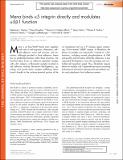| dc.contributor.author | Gupton, Stephanie L. | |
| dc.contributor.author | Riquelme, Daisy Noelia | |
| dc.contributor.author | Hughes-Alford, Shannon Kay | |
| dc.contributor.author | Tadros, Jenny | |
| dc.contributor.author | Rudina, Shireen S. | |
| dc.contributor.author | Hynes, Richard O. | |
| dc.contributor.author | Lauffenburger, Douglas A. | |
| dc.contributor.author | Gertler, Frank | |
| dc.date.accessioned | 2012-11-19T17:23:21Z | |
| dc.date.available | 2012-11-19T17:23:21Z | |
| dc.date.issued | 2012-08 | |
| dc.date.submitted | 2012-02 | |
| dc.identifier.issn | 0021-9525 | |
| dc.identifier.issn | 1540-8140 | |
| dc.identifier.uri | http://hdl.handle.net/1721.1/74675 | |
| dc.description.abstract | Mena is an Ena/VASP family actin regulator with roles in cell migration, chemotaxis, cell–cell adhesion, tumor cell invasion, and metastasis. Although enriched in focal adhesions, Mena has no established function within these structures. We find that Mena forms an adhesion-regulated complex with α5β1 integrin, a fibronectin receptor involved in cell adhesion, motility, fibronectin fibrillogenesis, signaling, and growth factor receptor trafficking. Mena bound directly to the carboxy-terminal portion of the α5 cytoplasmic tail via a 91-residue region containing 13 five-residue “LERER” repeats. In fibroblasts, the Mena–α5 complex was required for “outside-in” α5β1 functions, including normal phosphorylation of FAK and paxillin and formation of fibrillar adhesions. It also supported fibrillogenesis and cell spreading and controlled cell migration speed. Thus, fibroblasts require Mena for multiple α5β1-dependent processes involving bidirectional interactions between the extracellular matrix and cytoplasmic focal adhesion proteins. | en_US |
| dc.description.sponsorship | National Institutes of Health (U.S.) (Grant GM58801) | en_US |
| dc.description.sponsorship | National Cancer Institute (U.S.) (Grant U54-CA112967) | en_US |
| dc.description.sponsorship | Howard Hughes Medical Institute | en_US |
| dc.language.iso | en_US | |
| dc.publisher | Rockefeller University Press, The | en_US |
| dc.relation.isversionof | http://dx.doi.org/10.1083/jcb.201202079 | en_US |
| dc.rights | Creative Commons Attribution-Noncommercial-Share Alike 3.0 Unported | en_US |
| dc.rights.uri | http://creativecommons.org/licenses/by-nc-sa/3.0/ | en_US |
| dc.source | Rockefeller UP | en_US |
| dc.title | Mena binds α5 integrin directly and modulates α5β1 function | en_US |
| dc.type | Article | en_US |
| dc.identifier.citation | Gupton, S. L. et al. “Mena binds α5 integrin directly and modulates α5β1 function.” The Journal of Cell Biology 198.4 (2012): 657–676. © 2012 by The Rockefeller University Press | en_US |
| dc.contributor.department | Massachusetts Institute of Technology. Department of Biological Engineering | en_US |
| dc.contributor.department | Massachusetts Institute of Technology. Department of Biology | en_US |
| dc.contributor.department | Koch Institute for Integrative Cancer Research at MIT | en_US |
| dc.contributor.mitauthor | Gupton, Stephanie L. | |
| dc.contributor.mitauthor | Riquelme, Daisy Noelia | |
| dc.contributor.mitauthor | Hughes-Alford, Shannon Kay | |
| dc.contributor.mitauthor | Tadros, Jenny | |
| dc.contributor.mitauthor | Rudina, Shireen S. | |
| dc.contributor.mitauthor | Hynes, Richard O. | |
| dc.contributor.mitauthor | Lauffenburger, Douglas A. | |
| dc.contributor.mitauthor | Gertler, Frank | |
| dc.relation.journal | Journal of Cell Biology | en_US |
| dc.eprint.version | Final published version | en_US |
| dc.type.uri | http://purl.org/eprint/type/JournalArticle | en_US |
| eprint.status | http://purl.org/eprint/status/PeerReviewed | en_US |
| dspace.orderedauthors | Gupton, S. L.; Riquelme, D.; Hughes-Alford, S. K.; Tadros, J.; Rudina, S. S.; Hynes, R. O.; Lauffenburger, D.; Gertler, F. B. | en |
| dc.identifier.orcid | https://orcid.org/0000-0003-3214-4554 | |
| dc.identifier.orcid | https://orcid.org/0000-0002-3048-7927 | |
| dc.identifier.orcid | https://orcid.org/0000-0001-7603-8396 | |
| dspace.mitauthor.error | true | |
| mit.license | PUBLISHER_CC | en_US |
| mit.metadata.status | Complete | |
